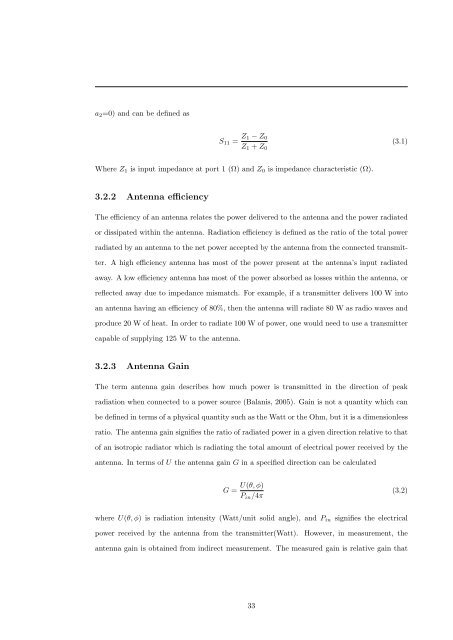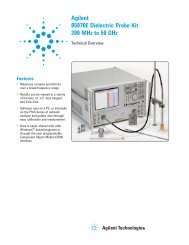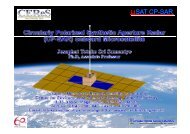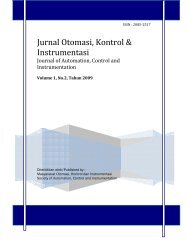Development of Circularly Polarized Microstrip ... - CEReS - åè大å¦
Development of Circularly Polarized Microstrip ... - CEReS - åè大å¦
Development of Circularly Polarized Microstrip ... - CEReS - åè大å¦
Create successful ePaper yourself
Turn your PDF publications into a flip-book with our unique Google optimized e-Paper software.
a 2 =0) and can be defined as<br />
S 11 = Z 1 − Z 0<br />
Z 1 + Z 0<br />
(3.1)<br />
Where Z 1 is input impedance at port 1 (Ω) and Z 0 is impedance characteristic (Ω).<br />
3.2.2 Antenna efficiency<br />
The efficiency <strong>of</strong> an antenna relates the power delivered to the antenna and the power radiated<br />
or dissipated within the antenna. Radiation efficiency is defined as the ratio <strong>of</strong> the total power<br />
radiated by an antenna to the net power accepted by the antenna from the connected transmitter.<br />
A high efficiency antenna has most <strong>of</strong> the power present at the antenna’s input radiated<br />
away. A low efficiency antenna has most <strong>of</strong> the power absorbed as losses within the antenna, or<br />
reflected away due to impedance mismatch. For example, if a transmitter delivers 100 W into<br />
an antenna having an efficiency <strong>of</strong> 80%, then the antenna will radiate 80 W as radio waves and<br />
produce 20 W <strong>of</strong> heat. In order to radiate 100 W <strong>of</strong> power, one would need to use a transmitter<br />
capable <strong>of</strong> supplying 125 W to the antenna.<br />
3.2.3 Antenna Gain<br />
The term antenna gain describes how much power is transmitted in the direction <strong>of</strong> peak<br />
radiation when connected to a power source (Balanis, 2005). Gain is not a quantity which can<br />
be defined in terms <strong>of</strong> a physical quantity such as the Watt or the Ohm, but it is a dimensionless<br />
ratio. The antenna gain signifies the ratio <strong>of</strong> radiated power in a given direction relative to that<br />
<strong>of</strong> an isotropic radiator which is radiating the total amount <strong>of</strong> electrical power received by the<br />
antenna. In terms <strong>of</strong> U the antenna gain G in a specified direction can be calculated<br />
G =<br />
U(θ, φ)<br />
P in /4π<br />
(3.2)<br />
where U(θ, φ) is radiation intensity (Watt/unit solid angle), and P in signifies the electrical<br />
power received by the antenna from the transmitter(Watt).<br />
However, in measurement, the<br />
antenna gain is obtained from indirect measurement. The measured gain is relative gain that<br />
33






